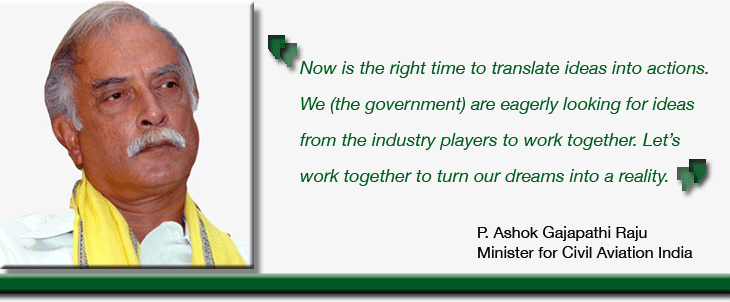
When Prime Minister Narendra
Modi’s cabinet recently opened the doors for the
$75 billion UAE investments in India’s infrastructure,
it also signaled the beginning of a project that had
been hampered by a lack of funds. Set for establishment
near Delhi’s international airport, the ECC or
Exhibition-cum-Convention Centre is only a part of a
project that includes an air cargo complex spread over
144 hectares of land. The project had been hanging in
mid-air for four years owing to a dispute between two
government bodies: the Delhi Development Authority and
the Japan-funded Delhi Mumbai Industrial Corridor Development
Corporation (DMICDC). Now, with the Cabinet directive,
the land has been transferred and work can begin soon.
Infrastructure has been
emphasized as a top priority time and again by the Minister
for Civil Aviation P. Ashok Gajapathi Raju. He stated
that infrastructure and airlines had a great role to
play for developing cargo hubs.
“Now,” he
said to his listeners at an air cargo seminar on transforming
India’s airports into international cargo hubs,
“is the right time to translate ideas into actions.
We (the government) are eagerly looking for ideas from
the industry players to work together. Let’s work
together to turn our dreams into a reality.”

That has brought cheer
to air cargo stakeholders—both Indian and foreign—who
have been harping on enhancement of infrastructure.
However, it is time to take a look at the situation.
To begin with, the economic reforms introduced by the
government, improvement in transportation facilities,
and industrial growth have not only created but also
enlarged the opportunities for logistics service providers
(LSP) in India. As a result, the Indian logistics industry
has been seeing development and expansion of its existing
infrastructure. Perhaps more importantly, the e-commerce
boom has ushered in a whole new brand of logistics solutions.
There is no doubt that
the country has potential. Gopal R., Global Vice President,
Supply Chain & Logistics Transformation Practice,
Frost & Sullivan put it rather aptly when he mentioned
that “India’s freight volumes are still
not justifying our economic size. Ideally, we should
be handling three to four times the freight volume that
we handle today, in comparison to other countries with
similar economic activity. This translates to huge potential,
which can lead to transformational growth of the Indian
logistics industry. We need to focus on ways to build
this freight volume through enhanced infrastructure
capacity, productivity, and process efficiency.”
Frost & Sullivan’s
recent study, ‘Indian Logistics Industry 2016
Outlook,’ has projected this potential: the logistics
industry is likely to grow at a CAGR of 8.6 percent
between 2015 and 2020. For its part, the government
has also taken measures to bring in growth. The Foreign
Trade Policy (2015-2020), for example, aims to increase
the value of trade to US $900 billion by 2020. Exports
will go up when manufacturers and others move ahead
in step with government initiatives like ‘Make
in India,’ ‘Digital India,’ and ‘Skills
India.’
The study mentions that
while sea freight—more than 70 percent of international
trade is through the country’s sea ports—could
grow by 5.7 percent driven by demand from Asia, Europe,
and Africa, international air freight is likely to grow
at 12.5 percent against domestic air cargo— that
comprises one-third of air cargo volume— which
could grow by 2.3 percent in 2016. Under the 12th Five
Year Plan (2012-17), an estimated US $11.4 billion has
been allocated for airport modernization and expansion.
For the present, 13 regional airports have been selected
for infrastructure expansion.
 Delhi
Airport’s head of Cargo and Chairman of The International
Air Cargo Association (TIACA) Sanjiv Edward (left) would
like the government’s commitment to “develop
the infrastructure to make the industry grow.”
The country needs to develop its gateways and that can
only be done with a commitment to enhancing the infrastructure
in “our gateways to get a place on the world map.” Delhi
Airport’s head of Cargo and Chairman of The International
Air Cargo Association (TIACA) Sanjiv Edward (left) would
like the government’s commitment to “develop
the infrastructure to make the industry grow.”
The country needs to develop its gateways and that can
only be done with a commitment to enhancing the infrastructure
in “our gateways to get a place on the world map.”
While the government is
keen to do its bit—the Airports Authority of India,
for example, has taken the responsibility of upgrading
and enhancing the infrastructure of 25 airports in the
country—it is the Public Private Partnership (PPP)
model that has yielded results. In fact, the Economic
Survey 2014-15 mentioned that the PPP model in Indian
airports had witnessed a significant growth in infrastructure.
 The
major initiatives to enhance the facilities came through
PPP projects at four of the AAI-controlled airports
at Chennai, Kolkata, Ahmedabad, and Jaipur. In addition,
a number of Greenfield airports were constructed. Cargo
throughput at airports in the country went up significantly:
International cargo throughput increased by 8.3 percent
and domestic by 19.3 percent in April-December 2014-15
compared with the corresponding period in 2013-14. The
major initiatives to enhance the facilities came through
PPP projects at four of the AAI-controlled airports
at Chennai, Kolkata, Ahmedabad, and Jaipur. In addition,
a number of Greenfield airports were constructed. Cargo
throughput at airports in the country went up significantly:
International cargo throughput increased by 8.3 percent
and domestic by 19.3 percent in April-December 2014-15
compared with the corresponding period in 2013-14.
All that air cargo stakeholders
are looking at now is action on the ground. The general
belief is that things will move once the National Aviation
Policy is implemented. Until then, air cargo infrastructure
will remain relegated to a simple cargo terminal at
airports. As Sam Katgara (right) from Jeena and Company,
one of the top freight forwarders, put it, “Cargo
infrastructure is much more than the cargo terminal,
but also includes special facilities for express freight,
temperature-controlled goods, airmail, and hazardous
goods.”
Tirthankar Ghosh
|






